
By: Baxter ’16, Jenna ’16 and Neidin ’14
When Zoah ’16 logged onto eFollet.com, planning to purchase her school books prior to the start of the semester, she was shocked by the exorbitant price tags attached to them. Although she had hoped to save money by renting textbooks or buying used books, her efforts proved futile: her Algebra II with Trigonometry book, though a used edition, cost $214.25, while her Chemistry book, also used, was $126.75. Although she had been outraged by high prices in previous years, the increased number of textbooks she needed for her sophomore classes sent the final price tag on her purchases skyrocketing.
Tuition for the 2013-2014 school year is $33,785. However, because tuition does not cover the full cost of attending Marlborough, students incur many additional fees including ones for textbooks, uniforms, and those included on a student’s supplemental bill.
Marlborough tries to be transparent about these costs by estimating what the total price of the additional fees will be for each grade level, but the extent of the charges is unclear to some parents and can catch them off guard. Families on financial aid receive a discount on certain expenses at Marlborough, but this discount doesn’t apply to all extra costs. What fees add to the cost of a Marlborough education? Why do textbook prices hit families so hard? What does the School do to help alleviate the burden of extra costs?
WHAT ARE YOU PAYING FOR?
Every year, the School’s website lists the cost of tuition and estimates additional fees for students in each grade, including the cost of transportation, should a student opt to take the bus. These estimates are the basis for the supplemental bill, which is separate from tuition and includes bills for class trips, fees for arts supplies and lab equipment, and polo shirts and sweatshirts ordered for sports teams or council members. Textbooks and uniforms are not included in the supplemental bill since they are purchased from vendors outside of Marlborough.
According to Assistant Head of School and Head of Upper School Laura Hotchkiss ’86, the School is working to increase the amount of information it gives parents regarding supplemental costs and additional fees. This year, for example, the School sent a letter to all senior parents informing them about the specific costs that will be included in their supplemental bills.
Seniors accumulate the largest supplemental bill because of added fees from the senior class trip to Hawaii, personalized graduation dresses, and senior portraits.
“The place where people complain the most is in senior year because there are a few charges that are more significant than they’ve probably seen in the past… so the idea would be to be more open about what those fees would be,” Hotchkiss said.
Some parents, including Carolyn, mother of Rachel ’19, said that they were pleased with the School’s efforts to let them know what to expect in terms of the cost of attending Marlborough.
“I remember being extremely impressed by [the website]… There was a really good breakdown of costs that I thought were very clear… I thought we were well informed in terms of what those costs would be,” she said.
Other parents, though aware that they would be billed for extra fees, remain unsure of the specific fees that are included in the additional bill. Martha, mother of Rachel ’16, said that she was not expecting one of the fees for which she was billed.
“I think that I’ve not been surprised by [costs such as] the uniform… I think where I was a little surprised is… if you’re taking an arts class you have to pay an extra fee. I would have expected that to be a part of the tuition,” Martha said.
BURDENSOME BOOKS
The cost of books is often the most surprising additional fee to students and the one that poses the greatest burden on families who might already be struggling to pay tuition. Depending on the classes a Marlborough student takes, the total price of a year’s textbooks could reach $2,000.
Why do textbooks cost so much? According to the Atlantic Online, a small group of major textbook publishers, including McGraw Hill, Harper Collins, and Houghton Mifflin, controls most of the $7 billion textbook market. Because these companies hold monopolies on book sales, they are able to artificially increase prices to boost their profits. Textbook costs have risen by 812% since 1978. Publishing companies also manipulate costs by releasing new editions with very few changes, essentially forcing students to buy newer, more expensive copies to keep up with the curriculum.
Some parents have expressed concern with the rising costs of textbooks.
“I kind of always have been upset about the cost of textbooks… I have always thought they were too much,” Martha said.
Although Marlborough teachers try to be conscious of textbook prices, Mathematics Department Head Chris Talone said it is often difficult to find inexpensive textbooks because the School chooses textbooks primarily for content and secondarily for price.
“We look for quality first. If we can save on costs, that’s a factor that comes in but it’s not the first thing we look at,” Talone said.
History Instructor John Langdon explained that teachers recognize that many families find it difficult to keep up with rising textbook prices and therefore allow leeway for students to purchase older editions.
“In most cases, the changes [in editions] are cosmetic. I always give the students permission to use earlier editions, as long as there aren’t major changes…The content is so close to the earlier edition that it’s a non-issue,” he said.
Genevieve ’14 mentioned that, although she has seen the prices of her textbooks rise steadily throughout her years at Marlborough, she believes that the School tries hard to save families money.
“I think the school has done a decent job, a pretty good job actually, of being aware of the additional prices that come with a Marlborough education. Of course, people will always say there is room to do more… but it’s also not like [the School] doesn’t do anything at all,” Genevieve said.
WHAT CAN THE SCHOOL DO?
Director of Admissions Jeanette Woo Chitjian explained that the School always looks for creative ways to reduce the cost of textbooks. Teachers attempt to use the same set of books for multiple courses, eliminating the need for students to buy a new set of books every year. The first two levels of Spanish offered at Marlborough, for example, require the same textbook. However, Woo Chitjian said that there are certain challenges to creating continuity across different courses.
“If it lends itself to the class, I think teachers are doing it. However, I think that there are lots of classes that are stand-alone classes like Geometry,” she said.
Marlborough’s long-standing relationship with Follet Books, the primary textbook supplier for students, also allows families to save money through discounts. Director of Operations Clinton Oie, who serves as the liaison to Follett Books, said that Marlborough often receives concessions from Follet, such as free shipping for the first two weeks after ordering opens.
Of course, students are also able to buy their books through sites like Amazon or through Marlborough-directed efforts like the end-of-the-year book swap, during which students return their used books in exchange for money or for the books required for future classes.
At the end of the last school year, Fiona ’15 participated in the book swap, where she traded in her old books for money and new copies.
“I know I got a lot of my books there… It was really helpful: I got several hundred dollars worth of books there just by trading in books,” Fiona said.
The cost of tuition and the supplemental bill may be partially or fully subsidized for the 20% of Marlborough families that receive financial aid, but the program does not cover charges such as textbooks or uniforms that must be acquired from outside vendors. Additionally, some families who do not meet the criteria to receive any financial aid are able to pay full tuition, but often struggle to pay for what can feel like exorbitant hidden fees. Director of Admissions Jeanette Woo Chitjian acknowledges that these costs hit certain families especially hard.
“The group that maybe we are most concerned about is that group that is paying the full tuition whose families are making difficult decisions,” she said.






